Pomegranate seeds
The seeds of the pomegranate, a deciduous tree or shrub, are small, angular particles with a larger end, sometimes formed by multiple seeds adhering together in a block. The outer seed coat shrinks on the surface of the seed, ranging from yellowish red to dark brown, sticky and sweet in taste. The endoderma is subbony, light reddish-brown in color, and relatively hard in texture. The kernel is milky white, and the cotyledons overlap and curl.
Chinese name: Pomegranate Seed Oil
Family and genus: Pomegranate genus of the Pomegranaceae family
Color: Light yellow or yellow transparent liquid.
Smell: It has the characteristic aroma of pomegranates
Preparation: Cold-pressed extraction
Extraction part: Seed
Fields and Applications
1.Cosmetics
Pomegranate seeds are rich in antioxidants and can be made into skin care products and hair care products, etc.
2. Food
It can be made into food additives and added to various foods and beverages, such as candies, baked goods, drinks, salad dressings, condiments, etc. It can not only increase the nutritional value of food, but also endow food with unique flavor and color, improving the quality and taste of products.
Daily usage
1. Skin care
Add 1-2 drops of pomegranate seed oil to your daily used face cream, lotion or essence, stir well and apply it to your face.
2. Body care
Take 5 to 10 drops of pomegranate seed oil and mix it with an appropriate amount of base oil (such as sweet almond oil or grape seed oil). It can be used as a body massage oil.
Post time: Jul-10-2025
